VOLVO V60 2014 Owners Manual
Manufacturer: VOLVO, Model Year: 2014, Model line: V60, Model: VOLVO V60 2014Pages: 442, PDF Size: 13.85 MB
Page 321 of 442
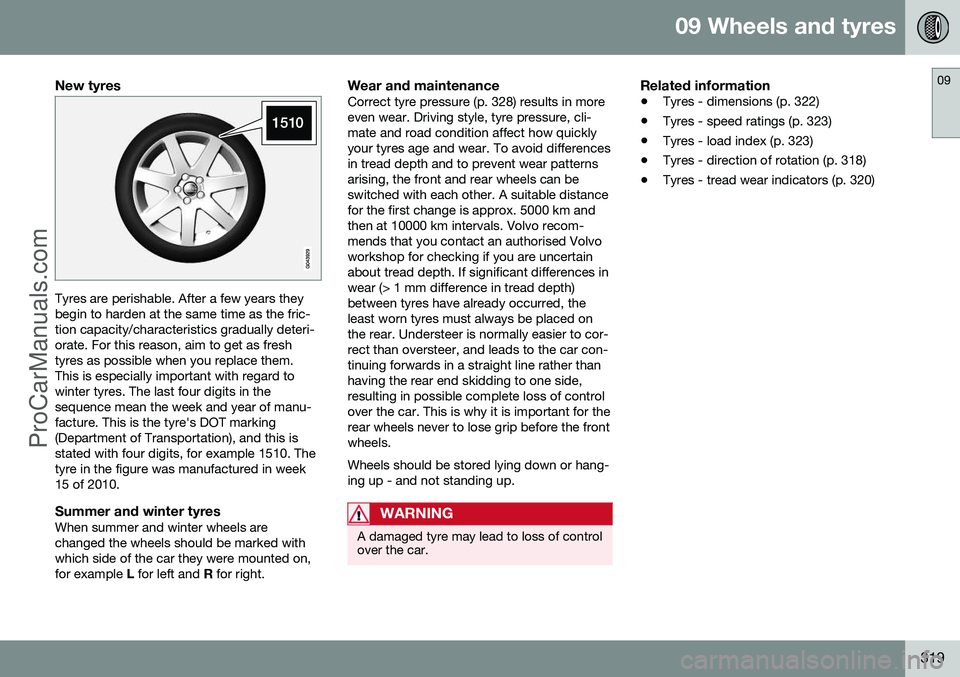
09 Wheels and tyres
09
319
New tyres
Tyres are perishable. After a few years they begin to harden at the same time as the fric-tion capacity/characteristics gradually deteri-orate. For this reason, aim to get as freshtyres as possible when you replace them.This is especially important with regard towinter tyres. The last four digits in thesequence mean the week and year of manu-facture. This is the tyre's DOT marking(Department of Transportation), and this isstated with four digits, for example 1510. Thetyre in the figure was manufactured in week15 of 2010.
Summer and winter tyresWhen summer and winter wheels arechanged the wheels should be marked withwhich side of the car they were mounted on,for example L for left and R for right.
Wear and maintenanceCorrect tyre pressure (p. 328) results in moreeven wear. Driving style, tyre pressure, cli-mate and road condition affect how quicklyyour tyres age and wear. To avoid differencesin tread depth and to prevent wear patternsarising, the front and rear wheels can beswitched with each other. A suitable distancefor the first change is approx. 5000 km andthen at 10000 km intervals. Volvo recom-mends that you contact an authorised Volvoworkshop for checking if you are uncertainabout tread depth. If significant differences inwear (> 1 mm difference in tread depth)between tyres have already occurred, theleast worn tyres must always be placed onthe rear. Understeer is normally easier to cor-rect than oversteer, and leads to the car con-tinuing forwards in a straight line rather thanhaving the rear end skidding to one side,resulting in possible complete loss of controlover the car. This is why it is important for therear wheels never to lose grip before the frontwheels. Wheels should be stored lying down or hang- ing up - and not standing up.
WARNING
A damaged tyre may lead to loss of control over the car.
Related information
• Tyres - dimensions (p. 322)
• Tyres - speed ratings (p. 323)
• Tyres - load index (p. 323)
• Tyres - direction of rotation (p. 318)
• Tyres - tread wear indicators (p. 320)
ProCarManuals.co’
Page 322 of 442
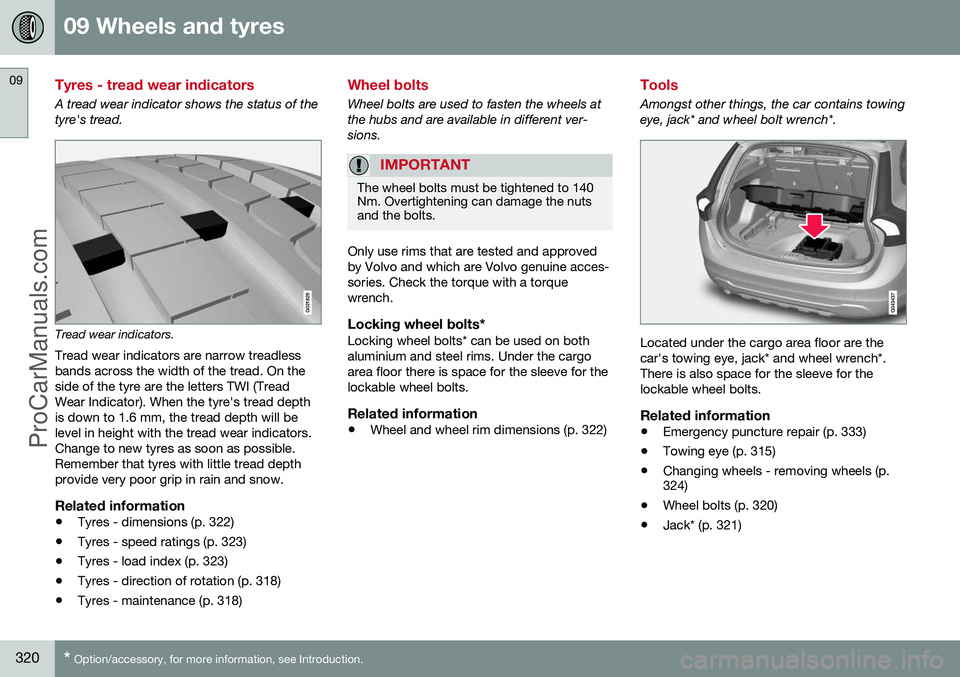
09 Wheels and tyres
09
320* Option/accessory, for more information, see Introduction.
Tyres - tread wear indicators
A tread wear indicator shows the status of the tyre's tread.
G021829
Tread wear indicators.
Tread wear indicators are narrow treadless bands across the width of the tread. On theside of the tyre are the letters TWI (TreadWear Indicator). When the tyre's tread depthis down to 1.6 mm, the tread depth will belevel in height with the tread wear indicators.Change to new tyres as soon as possible.Remember that tyres with little tread depthprovide very poor grip in rain and snow.
Related information
• Tyres - dimensions (p. 322)
• Tyres - speed ratings (p. 323)
• Tyres - load index (p. 323)
• Tyres - direction of rotation (p. 318)
• Tyres - maintenance (p. 318)
Wheel bolts
Wheel bolts are used to fasten the wheels at the hubs and are available in different ver-sions.
IMPORTANT
The wheel bolts must be tightened to 140 Nm. Overtightening can damage the nutsand the bolts.
Only use rims that are tested and approved by Volvo and which are Volvo genuine acces-sories. Check the torque with a torquewrench.
Locking wheel bolts*Locking wheel bolts* can be used on bothaluminium and steel rims. Under the cargoarea floor there is space for the sleeve for thelockable wheel bolts.
Related information
•
Wheel and wheel rim dimensions (p. 322)
Tools
Amongst other things, the car contains towing
eye, jack* and wheel bolt wrench*.
Located under the cargo area floor are the car's towing eye, jack* and wheel wrench*.There is also space for the sleeve for thelockable wheel bolts.
Related information
• Emergency puncture repair (p. 333)
• Towing eye (p. 315)
• Changing wheels - removing wheels (p. 324)
• Wheel bolts (p. 320)
• Jack* (p. 321)
ProCarManuals.co’
Page 323 of 442
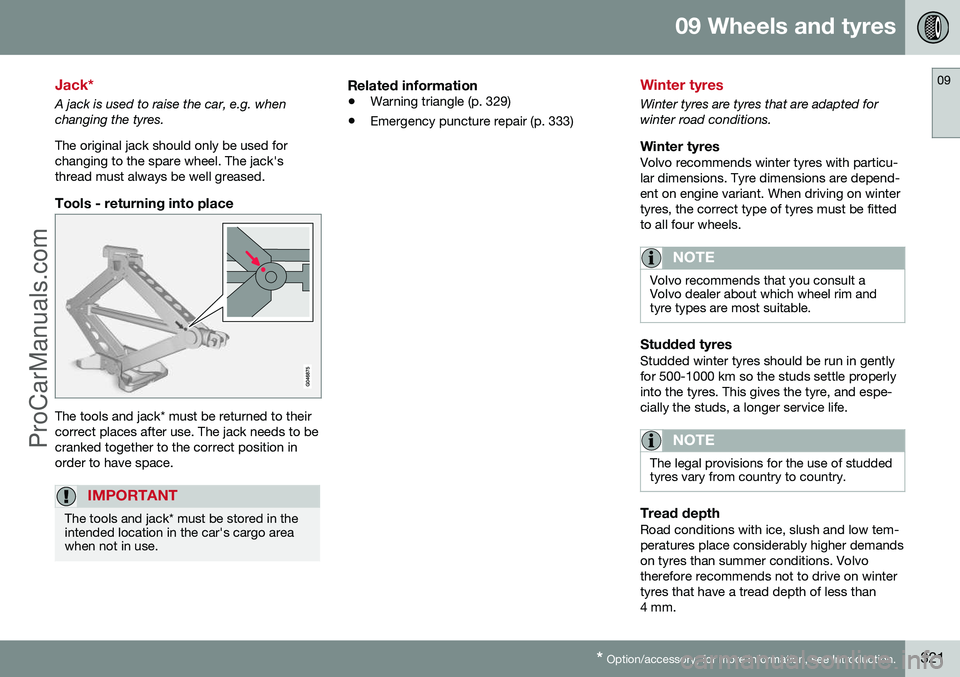
09 Wheels and tyres
09
* Option/accessory, for more information, see Introduction.321
Jack*
A jack is used to raise the car, e.g. when changing the tyres. The original jack should only be used for changing to the spare wheel. The jack'sthread must always be well greased.
Tools - returning into place
The tools and jack* must be returned to their correct places after use. The jack needs to becranked together to the correct position inorder to have space.
IMPORTANT
The tools and jack* must be stored in the intended location in the car's cargo areawhen not in use.
Related information
• Warning triangle (p. 329)
• Emergency puncture repair (p. 333)
Winter tyres
Winter tyres are tyres that are adapted for winter road conditions.
Winter tyresVolvo recommends winter tyres with particu-lar dimensions. Tyre dimensions are depend-ent on engine variant. When driving on wintertyres, the correct type of tyres must be fittedto all four wheels.
NOTE
Volvo recommends that you consult a Volvo dealer about which wheel rim andtyre types are most suitable.
Studded tyresStudded winter tyres should be run in gently for 500-1000 km so the studs settle properlyinto the tyres. This gives the tyre, and espe-cially the studs, a longer service life.
NOTE
The legal provisions for the use of studded tyres vary from country to country.
Tread depthRoad conditions with ice, slush and low tem- peratures place considerably higher demandson tyres than summer conditions. Volvotherefore recommends not to drive on wintertyres that have a tread depth of less than4 mm.
ProCarManuals.co’
Page 324 of 442
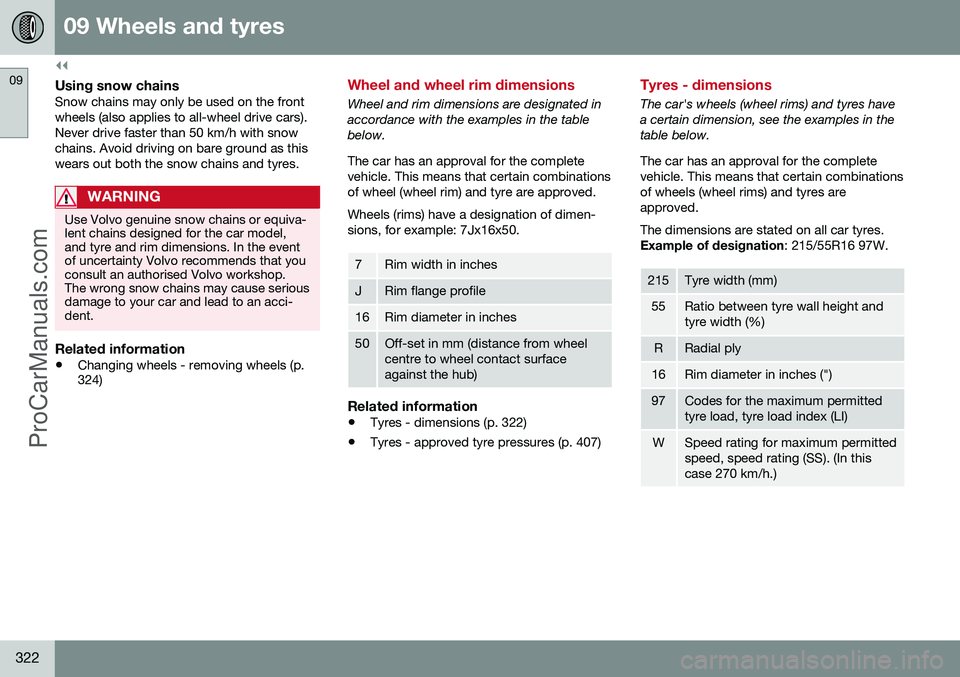
||
09 Wheels and tyres
09
322
Using snow chainsSnow chains may only be used on the front wheels (also applies to all-wheel drive cars).Never drive faster than 50 km/h with snowchains. Avoid driving on bare ground as thiswears out both the snow chains and tyres.
WARNING
Use Volvo genuine snow chains or equiva- lent chains designed for the car model,and tyre and rim dimensions. In the eventof uncertainty Volvo recommends that youconsult an authorised Volvo workshop.The wrong snow chains may cause seriousdamage to your car and lead to an acci-dent.
Related information
•Changing wheels - removing wheels (p. 324)
Wheel and wheel rim dimensions
Wheel and rim dimensions are designated in accordance with the examples in the tablebelow. The car has an approval for the complete vehicle. This means that certain combinationsof wheel (wheel rim) and tyre are approved. Wheels (rims) have a designation of dimen- sions, for example: 7Jx16x50.
7Rim width in inches
JRim flange profile
16Rim diameter in inches
50Off-set in mm (distance from wheel centre to wheel contact surfaceagainst the hub)
Related information
•
Tyres - dimensions (p. 322)
• Tyres - approved tyre pressures (p. 407)
Tyres - dimensions
The car's wheels (wheel rims) and tyres have a certain dimension, see the examples in thetable below. The car has an approval for the complete vehicle. This means that certain combinationsof wheels (wheel rims) and tyres areapproved. The dimensions are stated on all car tyres. Example of designation
: 215/55R16 97W.
215Tyre width (mm)
55Ratio between tyre wall height and tyre width (%)
RRadial ply
16Rim diameter in inches (")
97Codes for the maximum permitted tyre load, tyre load index (LI)
WSpeed rating for maximum permitted speed, speed rating (SS). (In thiscase 270 km/h.)
ProCarManuals.co’
Page 325 of 442
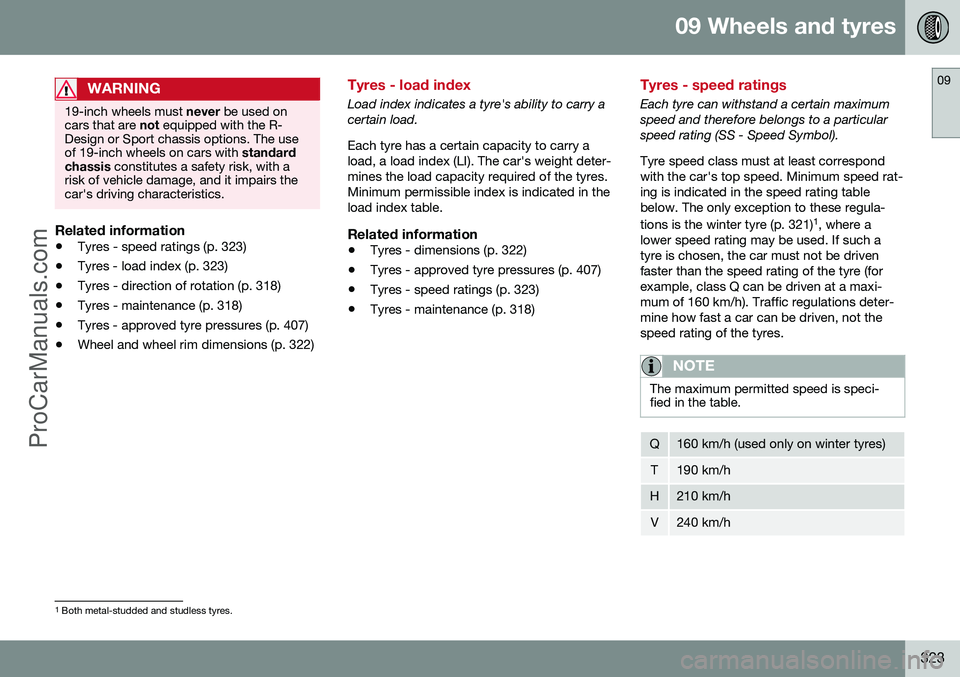
09 Wheels and tyres
09
323
WARNING
19-inch wheels must never be used on
cars that are not equipped with the R-
Design or Sport chassis options. The use of 19-inch wheels on cars with standard
chassis constitutes a safety risk, with a
risk of vehicle damage, and it impairs thecar's driving characteristics.
Related information
• Tyres - speed ratings (p. 323)
• Tyres - load index (p. 323)
• Tyres - direction of rotation (p. 318)
• Tyres - maintenance (p. 318)
• Tyres - approved tyre pressures (p. 407)
• Wheel and wheel rim dimensions (p. 322)
Tyres - load index
Load index indicates a tyre's ability to carry a certain load. Each tyre has a certain capacity to carry a load, a load index (LI). The car's weight deter-mines the load capacity required of the tyres.Minimum permissible index is indicated in theload index table.
Related information
•Tyres - dimensions (p. 322)
• Tyres - approved tyre pressures (p. 407)
• Tyres - speed ratings (p. 323)
• Tyres - maintenance (p. 318)
Tyres - speed ratings
Each tyre can withstand a certain maximum speed and therefore belongs to a particularspeed rating (SS - Speed Symbol). Tyre speed class must at least correspond with the car's top speed. Minimum speed rat-ing is indicated in the speed rating tablebelow. The only exception to these regula- tions is the winter tyre (p. 321) 1
, where a
lower speed rating may be used. If such a tyre is chosen, the car must not be drivenfaster than the speed rating of the tyre (forexample, class Q can be driven at a maxi-mum of 160 km/h). Traffic regulations deter-mine how fast a car can be driven, not thespeed rating of the tyres.
NOTE
The maximum permitted speed is speci- fied in the table.
Q160 km/h (used only on winter tyres)
T190 km/h
H210 km/h
V240 km/h
1 Both metal-studded and studless tyres.
ProCarManuals.co’
Page 326 of 442
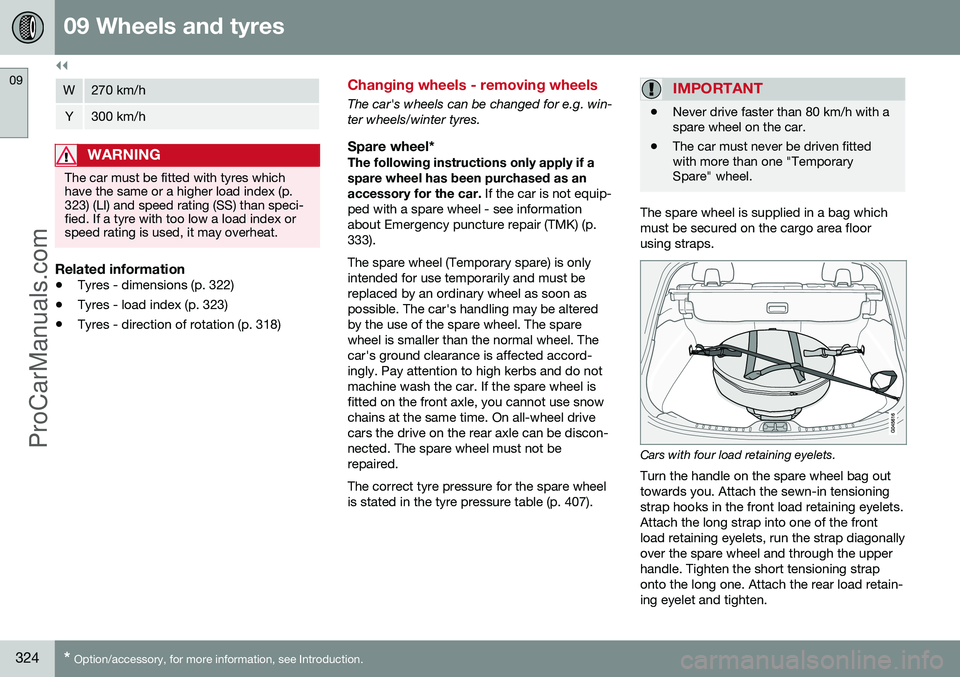
||
09 Wheels and tyres
09
324* Option/accessory, for more information, see Introduction.
W270 km/h
Y300 km/h
WARNING
The car must be fitted with tyres which have the same or a higher load index (p.323) (LI) and speed rating (SS) than speci-fied. If a tyre with too low a load index orspeed rating is used, it may overheat.
Related information
• Tyres - dimensions (p. 322)
• Tyres - load index (p. 323)
• Tyres - direction of rotation (p. 318)
Changing wheels - removing wheels
The car's wheels can be changed for e.g. win- ter wheels/winter tyres.
Spare wheel*The following instructions only apply if aspare wheel has been purchased as an accessory for the car.
If the car is not equip-
ped with a spare wheel - see information about Emergency puncture repair (TMK) (p.333). The spare wheel (Temporary spare) is only intended for use temporarily and must bereplaced by an ordinary wheel as soon aspossible. The car's handling may be alteredby the use of the spare wheel. The sparewheel is smaller than the normal wheel. Thecar's ground clearance is affected accord-ingly. Pay attention to high kerbs and do notmachine wash the car. If the spare wheel isfitted on the front axle, you cannot use snowchains at the same time. On all-wheel drivecars the drive on the rear axle can be discon-nected. The spare wheel must not berepaired. The correct tyre pressure for the spare wheel is stated in the tyre pressure table (p. 407).
IMPORTANT
• Never drive faster than 80 km/h with a spare wheel on the car.
• The car must never be driven fittedwith more than one "TemporarySpare" wheel.
The spare wheel is supplied in a bag which must be secured on the cargo area floorusing straps.
Cars with four load retaining eyelets.
Turn the handle on the spare wheel bag out towards you. Attach the sewn-in tensioningstrap hooks in the front load retaining eyelets.Attach the long strap into one of the frontload retaining eyelets, run the strap diagonallyover the spare wheel and through the upperhandle. Tighten the short tensioning straponto the long one. Attach the rear load retain-ing eyelet and tighten.
ProCarManuals.co’
Page 327 of 442
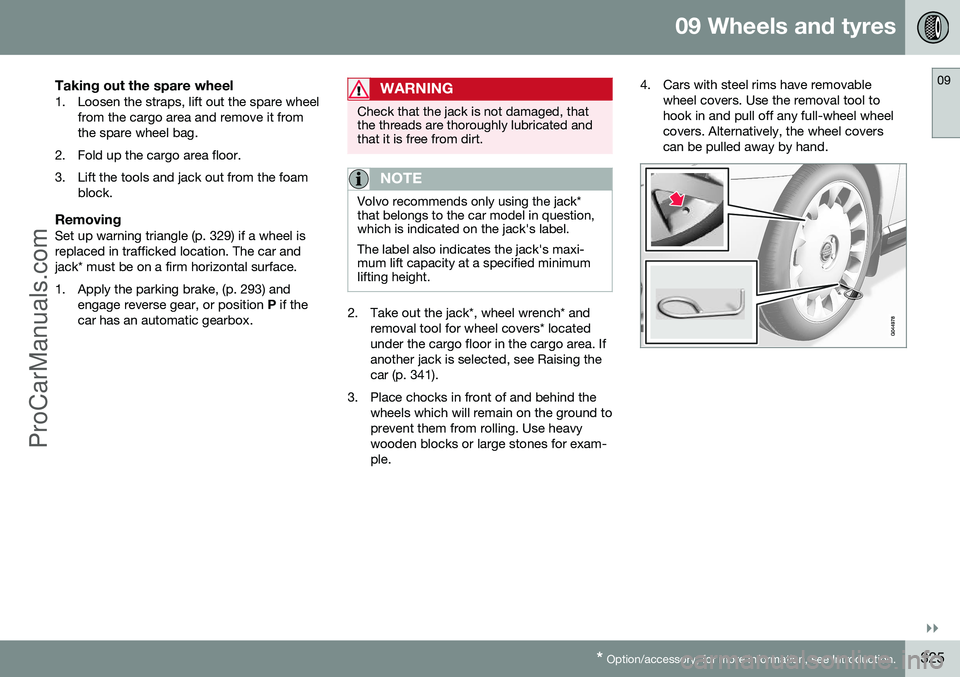
09 Wheels and tyres
09
}}
* Option/accessory, for more information, see Introduction.325
Taking out the spare wheel1. Loosen the straps, lift out the spare wheel
from the cargo area and remove it from the spare wheel bag.
2. Fold up the cargo area floor.
3. Lift the tools and jack out from the foam block.
RemovingSet up warning triangle (p. 329) if a wheel is replaced in trafficked location. The car andjack* must be on a firm horizontal surface.
1. Apply the parking brake, (p. 293) andengage reverse gear, or position P if the
car has an automatic gearbox.
WARNING
Check that the jack is not damaged, that the threads are thoroughly lubricated andthat it is free from dirt.
NOTE
Volvo recommends only using the jack* that belongs to the car model in question,which is indicated on the jack's label. The label also indicates the jack's maxi- mum lift capacity at a specified minimumlifting height.
2. Take out the jack*, wheel wrench* and removal tool for wheel covers* located under the cargo floor in the cargo area. Ifanother jack is selected, see Raising thecar (p. 341).
3. Place chocks in front of and behind the wheels which will remain on the ground toprevent them from rolling. Use heavywooden blocks or large stones for exam-ple. 4. Cars with steel rims have removable
wheel covers. Use the removal tool tohook in and pull off any full-wheel wheelcovers. Alternatively, the wheel coverscan be pulled away by hand.
ProCarManuals.co’
Page 328 of 442
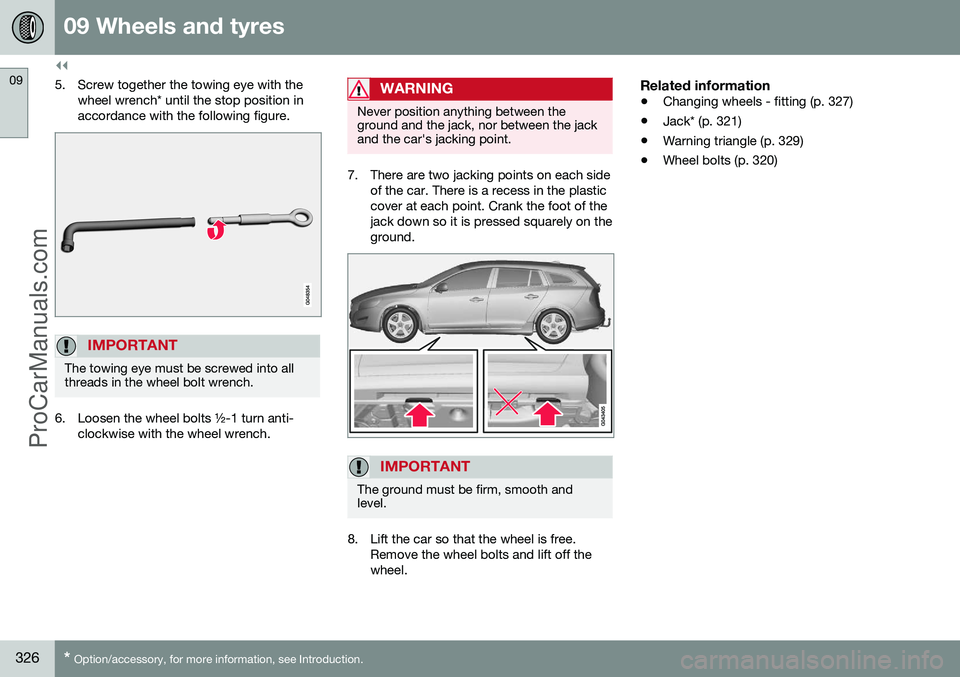
||
09 Wheels and tyres
09
326* Option/accessory, for more information, see Introduction.
5. Screw together the towing eye with the
wheel wrench* until the stop position in accordance with the following figure.
IMPORTANT
The towing eye must be screwed into all threads in the wheel bolt wrench.
6. Loosen the wheel bolts ½-1 turn anti-clockwise with the wheel wrench.
WARNING
Never position anything between the ground and the jack, nor between the jackand the car's jacking point.
7. There are two jacking points on each sideof the car. There is a recess in the plastic cover at each point. Crank the foot of thejack down so it is pressed squarely on theground.
IMPORTANT
The ground must be firm, smooth and level.
8. Lift the car so that the wheel is free.Remove the wheel bolts and lift off the wheel.
Related information
• Changing wheels - fitting (p. 327)
• Jack* (p. 321)
• Warning triangle (p. 329)
• Wheel bolts (p. 320)
ProCarManuals.co’
Page 329 of 442
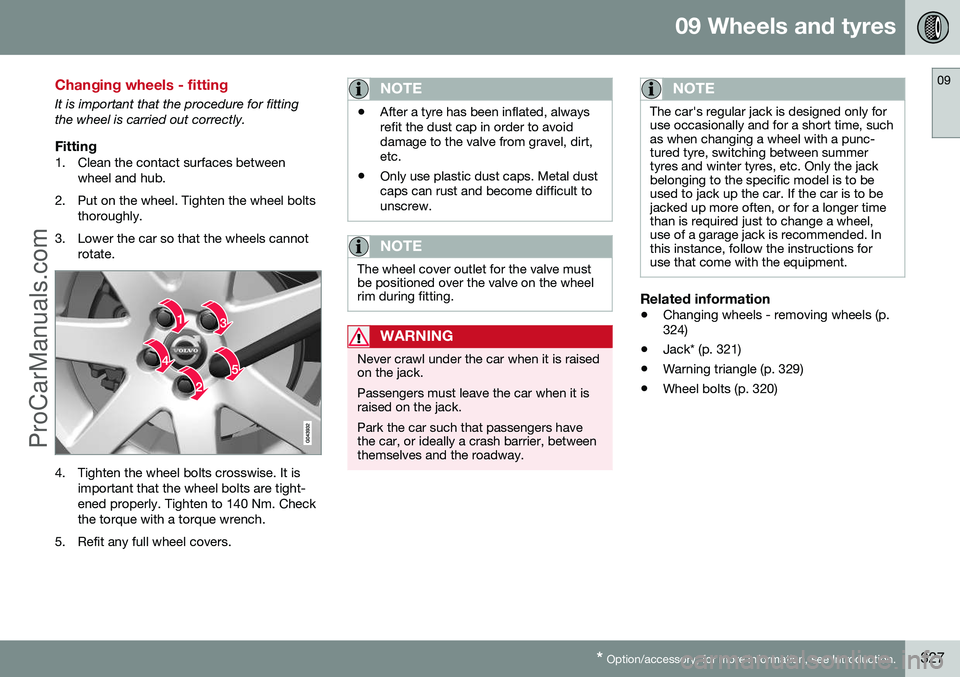
09 Wheels and tyres
09
* Option/accessory, for more information, see Introduction.327
Changing wheels - fitting
It is important that the procedure for fitting the wheel is carried out correctly.
Fitting1. Clean the contact surfaces between
wheel and hub.
2. Put on the wheel. Tighten the wheel bolts thoroughly.
3. Lower the car so that the wheels cannot rotate.
4. Tighten the wheel bolts crosswise. It isimportant that the wheel bolts are tight- ened properly. Tighten to 140 Nm. Checkthe torque with a torque wrench.
5. Refit any full wheel covers.
NOTE
• After a tyre has been inflated, always refit the dust cap in order to avoiddamage to the valve from gravel, dirt,etc.
• Only use plastic dust caps. Metal dustcaps can rust and become difficult tounscrew.
NOTE
The wheel cover outlet for the valve must be positioned over the valve on the wheelrim during fitting.
WARNING
Never crawl under the car when it is raised on the jack. Passengers must leave the car when it is raised on the jack. Park the car such that passengers have the car, or ideally a crash barrier, betweenthemselves and the roadway.
NOTE
The car's regular jack is designed only for use occasionally and for a short time, suchas when changing a wheel with a punc-tured tyre, switching between summertyres and winter tyres, etc. Only the jackbelonging to the specific model is to beused to jack up the car. If the car is to bejacked up more often, or for a longer timethan is required just to change a wheel,use of a garage jack is recommended. Inthis instance, follow the instructions foruse that come with the equipment.
Related information
•
Changing wheels - removing wheels (p. 324)
• Jack* (p. 321)
• Warning triangle (p. 329)
• Wheel bolts (p. 320)
ProCarManuals.co’
Page 330 of 442
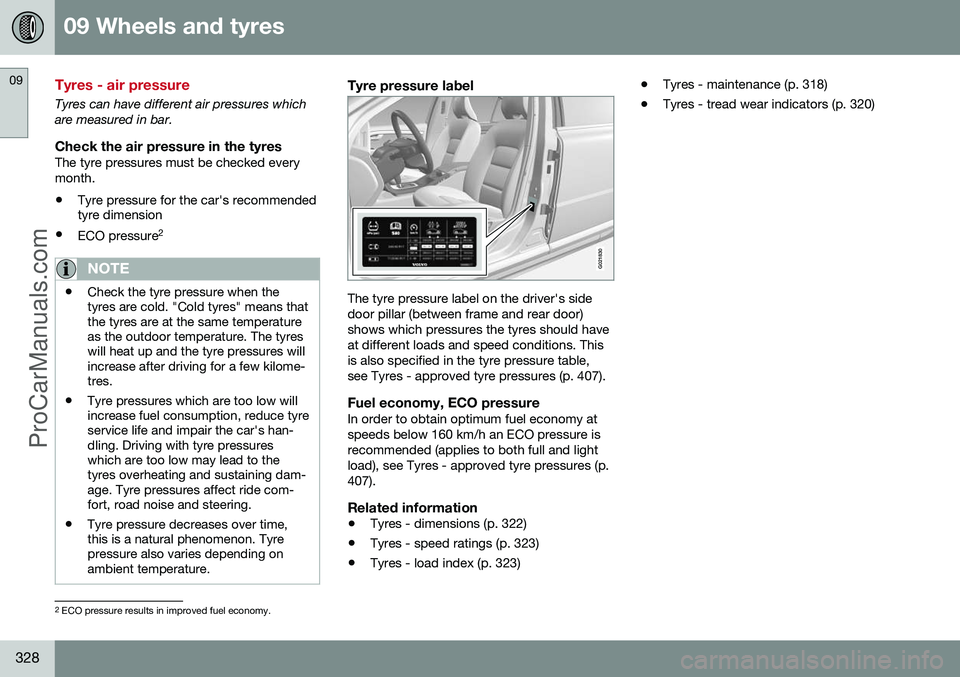
09 Wheels and tyres
09
328
Tyres - air pressure
Tyres can have different air pressures which are measured in bar.
Check the air pressure in the tyresThe tyre pressures must be checked everymonth.
• Tyre pressure for the car's recommended tyre dimension
• ECO pressure 2
NOTE
•
Check the tyre pressure when the tyres are cold. "Cold tyres" means thatthe tyres are at the same temperatureas the outdoor temperature. The tyreswill heat up and the tyre pressures willincrease after driving for a few kilome-tres.
• Tyre pressures which are too low willincrease fuel consumption, reduce tyreservice life and impair the car's han-dling. Driving with tyre pressureswhich are too low may lead to thetyres overheating and sustaining dam-age. Tyre pressures affect ride com-fort, road noise and steering.
• Tyre pressure decreases over time,this is a natural phenomenon. Tyrepressure also varies depending onambient temperature.
Tyre pressure label
G021830
The tyre pressure label on the driver's side door pillar (between frame and rear door)shows which pressures the tyres should haveat different loads and speed conditions. Thisis also specified in the tyre pressure table,see Tyres - approved tyre pressures (p. 407).
Fuel economy, ECO pressureIn order to obtain optimum fuel economy atspeeds below 160 km/h an ECO pressure isrecommended (applies to both full and lightload), see Tyres - approved tyre pressures (p.407).
Related information
•
Tyres - dimensions (p. 322)
• Tyres - speed ratings (p. 323)
• Tyres - load index (p. 323) •
Tyres - maintenance (p. 318)
• Tyres - tread wear indicators (p. 320)
2
ECO pressure results in improved fuel economy.
ProCarManuals.co’